



medschoolcoach 



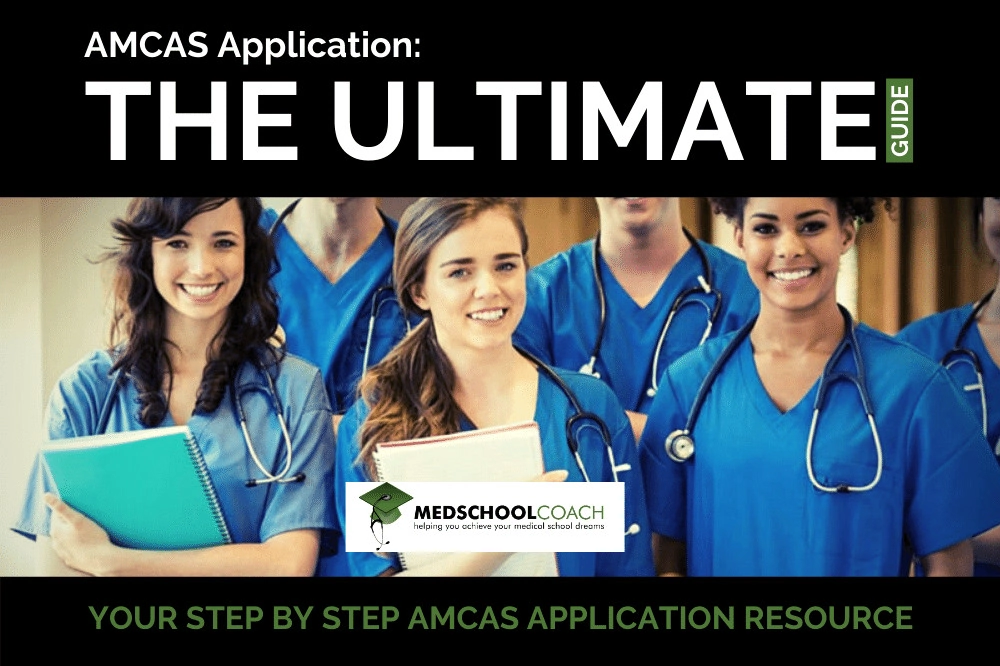
The AMCAS (American Medical College Application Service) is the centralized application system used by all allopathic medical schools (MD schools) in the United States. AMCAS is managed by the AAMC (Association of American Medical Colleges) in Washington, D.C.
Important AMCAS dates and deadlines:
Are you also applying to DO schools or any medical programs in Texas? Check out our guides to AACOMAS (osteopathic schools) or TMDSAS (Texas medical programs).
I’ll walk you through what to expect when submitting your primary application through AMCAS, including a step-by-step guide with screenshots.
The AMCAS application window opens the first week of May each year. However, there are actions you should take in preparation for the AMCAS application even before it officially opens.
Medical schools typically use a rolling admissions process, which means applications are reviewed as admissions officers receive them. We recommend submitting your application as early as possible (the first week of June is ideal) to avoid delays in being verified.
September-December 2023:
January-May 2024:
June-August 2024:
From September 2024 through February 2025, you may receive requests to interview at one or more programs. Most schools operate on a rolling admissions process, meaning they accept students right away who successfully complete interviews. Others may wait until all interviews are complete before sending acceptance letters as late as March 2025.
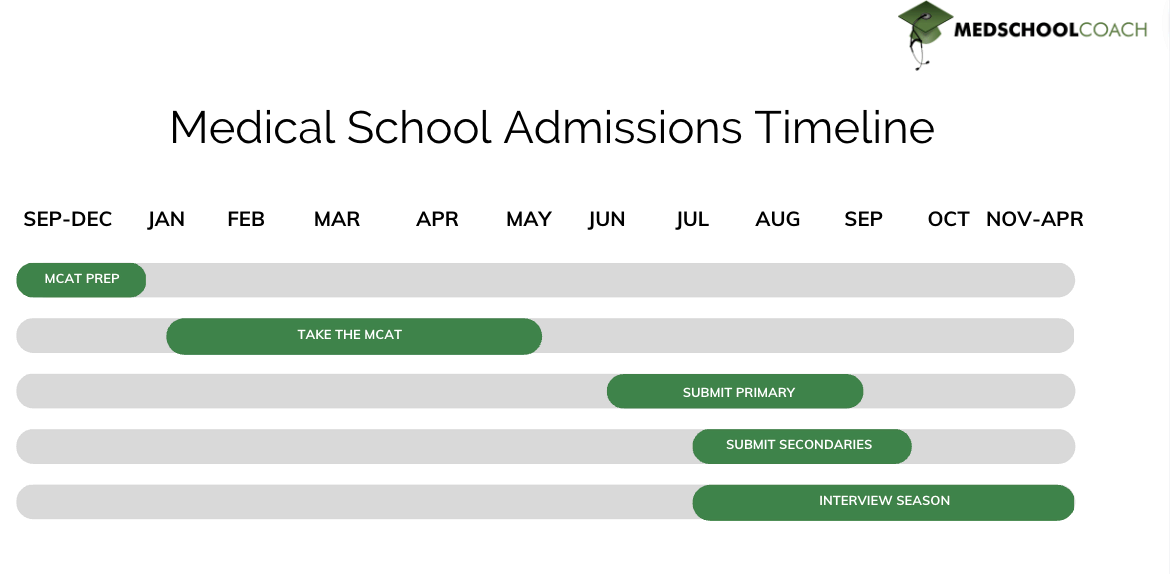
Although you can spread your time across several months, filling out the AMCAS will take many hours. Pre-draft your personal statement and work/activities months in advance, and print out all your transcripts. That way, filling everything out will only take 2-6 hours.
There are 9 AMCAS application sections:
You must fill out the Identifying Information and Schools Attended sections before you can proceed to other sections. The Medical Schools section can only be opened after you’ve completed the Biographic Information section.
Note: Some of these sections are simply informational, while others are used to assess you as a candidate on a personal, academic, and professional level.
The AAMC defines core competencies that pre-medical candidates should demonstrate on their primary application. It’s a good idea to understand these competencies so you have the best shot at crafting an application that stands out from the rest.
Keep reading to learn more details about completing each section.
Set up your account with AMCAS so you can fill out their online med school application:
Select from available application cycles.

Pro Tip: Start early and go slowly, carefully checking every field of the application as you go. You can save and edit the application as many times as you want before hitting submit. Even the tiniest errors in grammar, capitalization, punctuation, etc. will reflect poorly on you with admissions committees.
Follow the prompts to enter your identifying information, including:

After filling out your name, click “Save & Continue to Application.”
You’ll be taken to an application main menu that shows your personal information, the 9 sections of the application (and whether they’re complete or not), quick links for help with your application, and your document statuses.
You won’t see an area to view your letters of evaluation/recommendation or transcripts since these are submitted directly to AMCAS.
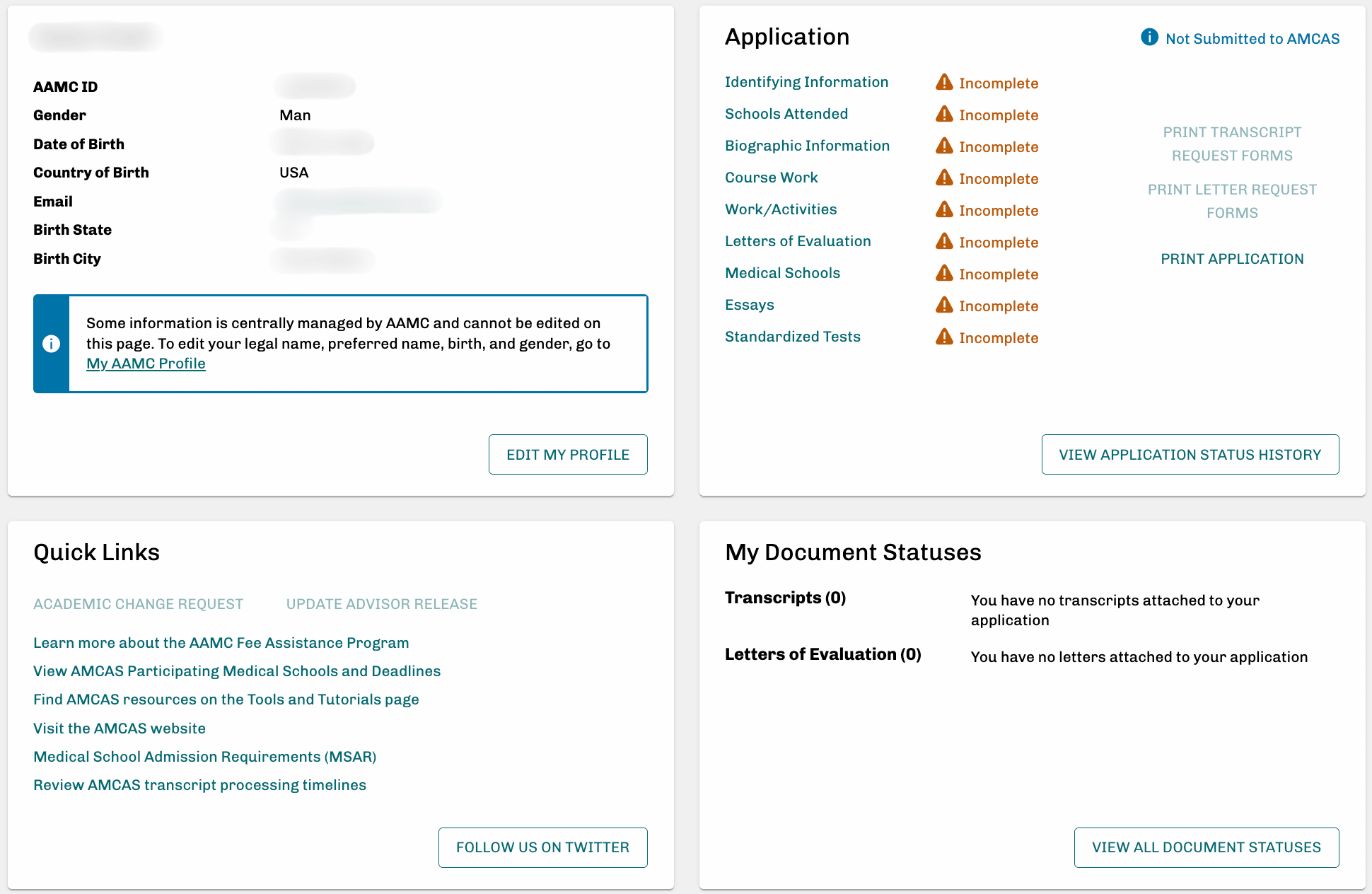
Most of the Identifying Information data is pulled over from your profile creation. Complete any missing or inaccurate information in this section until a checkmark shows the section is completed.
In the Schools Attended section, you’ll enter the information for your high school and colleges, including any attempted postsecondary, foreign/study abroad, or military education.
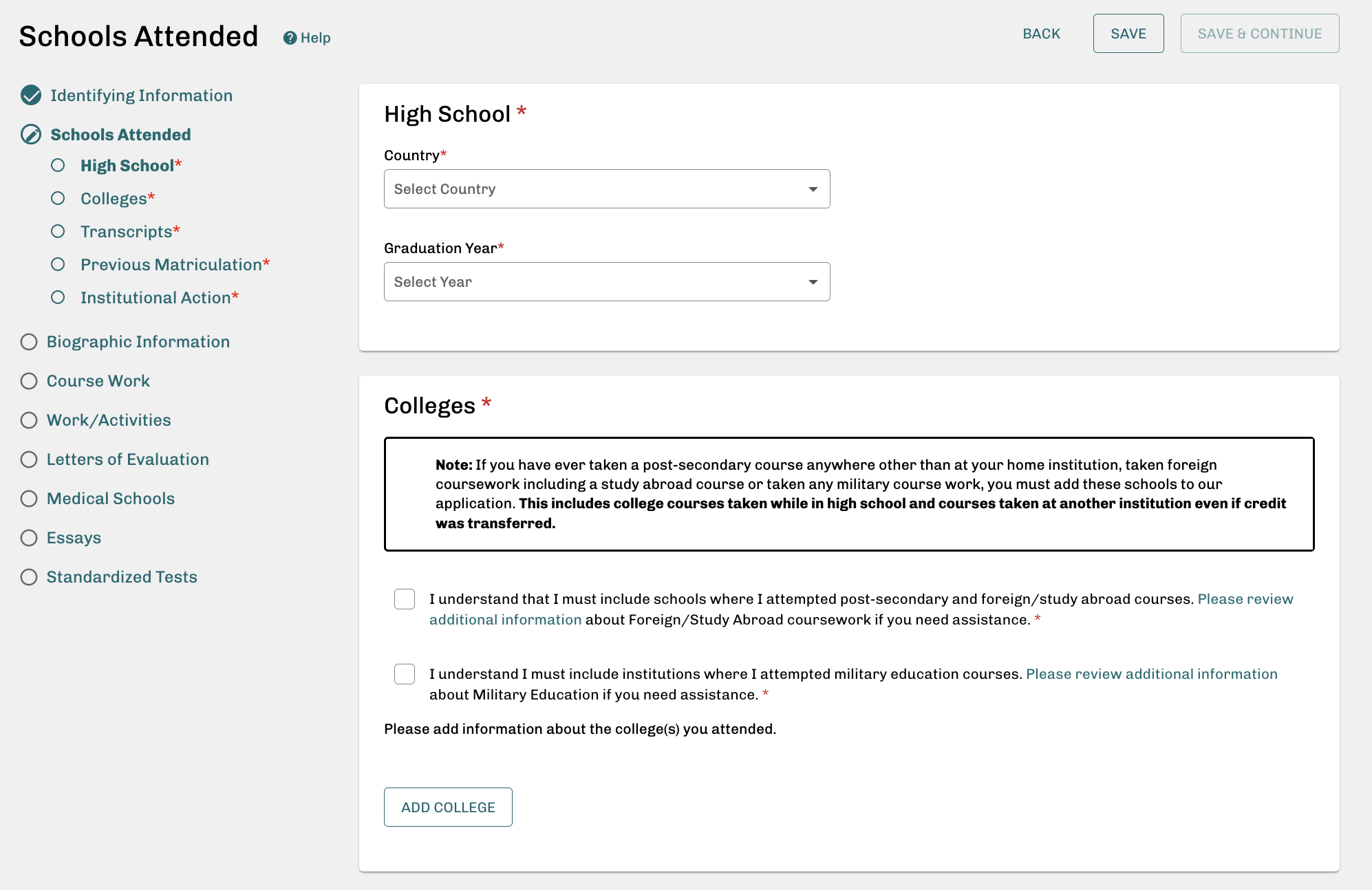
You will also have to state whether you have matriculated as a medical school student previously and whether you were ever the recipient of any institutional action by any college or medical school for unacceptable academic performance or conduct.
This is also where you’ll first see the notice that official transcripts are submitted directly to AMCAS from your school’s registrar. Once you enter a college’s information, you’ll have an opportunity to create a transcript request form.
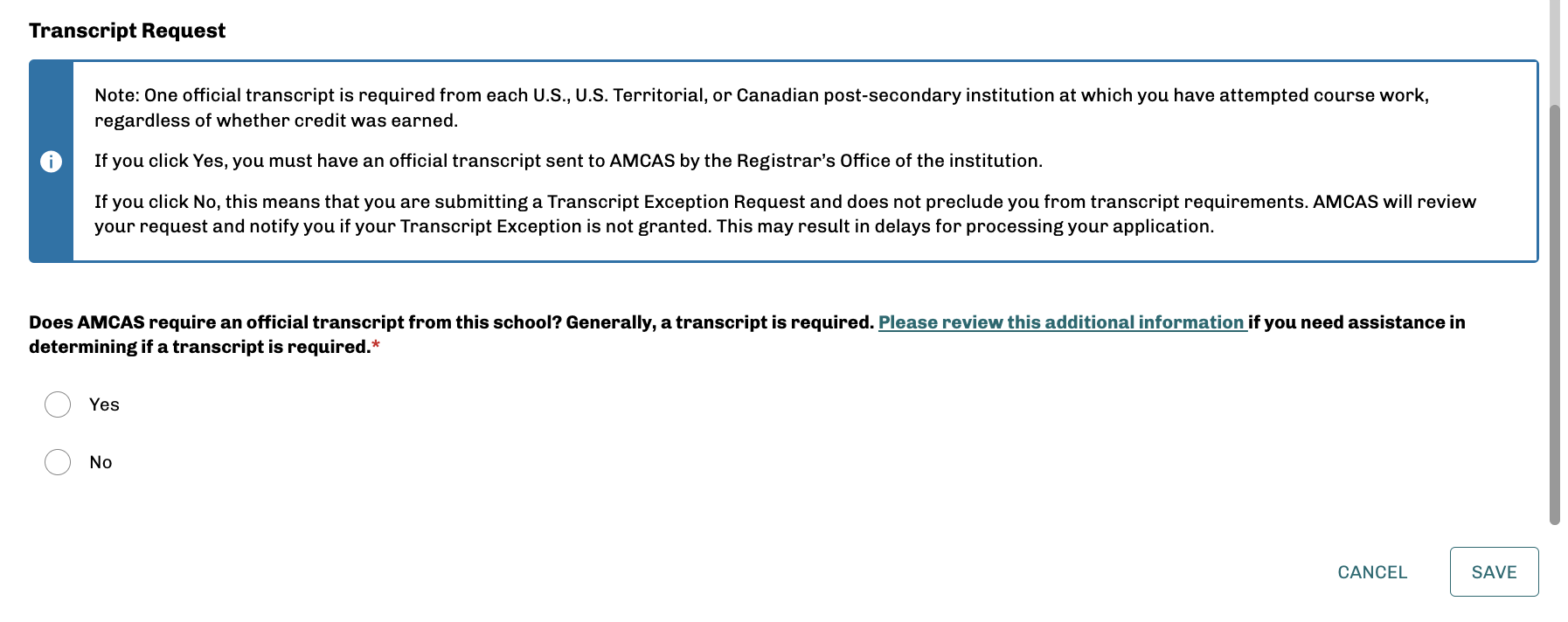
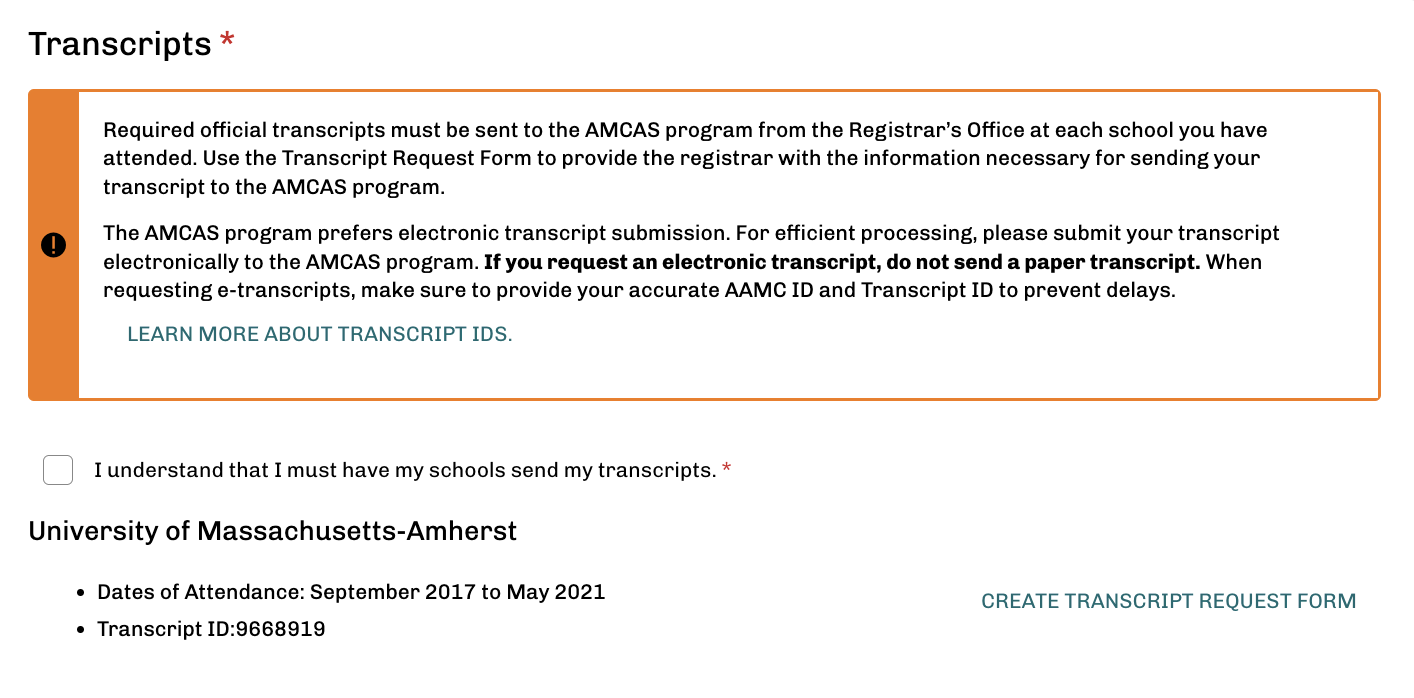
Biographic Information is a hefty section with a ton of personal information and background. Go step-by-step and fill in the blanks as indicated. These prompts include:
*The “Other Impactful Experiences” question is a new addition to the section as of 2024. It replaces the “Disadvantaged Status” question seen in previous application cycles. You’ll be asked whether you would like to describe “challenges or obstacles in your life” in order to “provide additional information… that is not easily captured in the rest of the application”.
If you answer Yes to the “Other Impactful Experiences” question, you’ll be expected to submit a narrative essay of 1,325 characters or less describing your experience and sharing how it “directly impacted your life opportunities.”
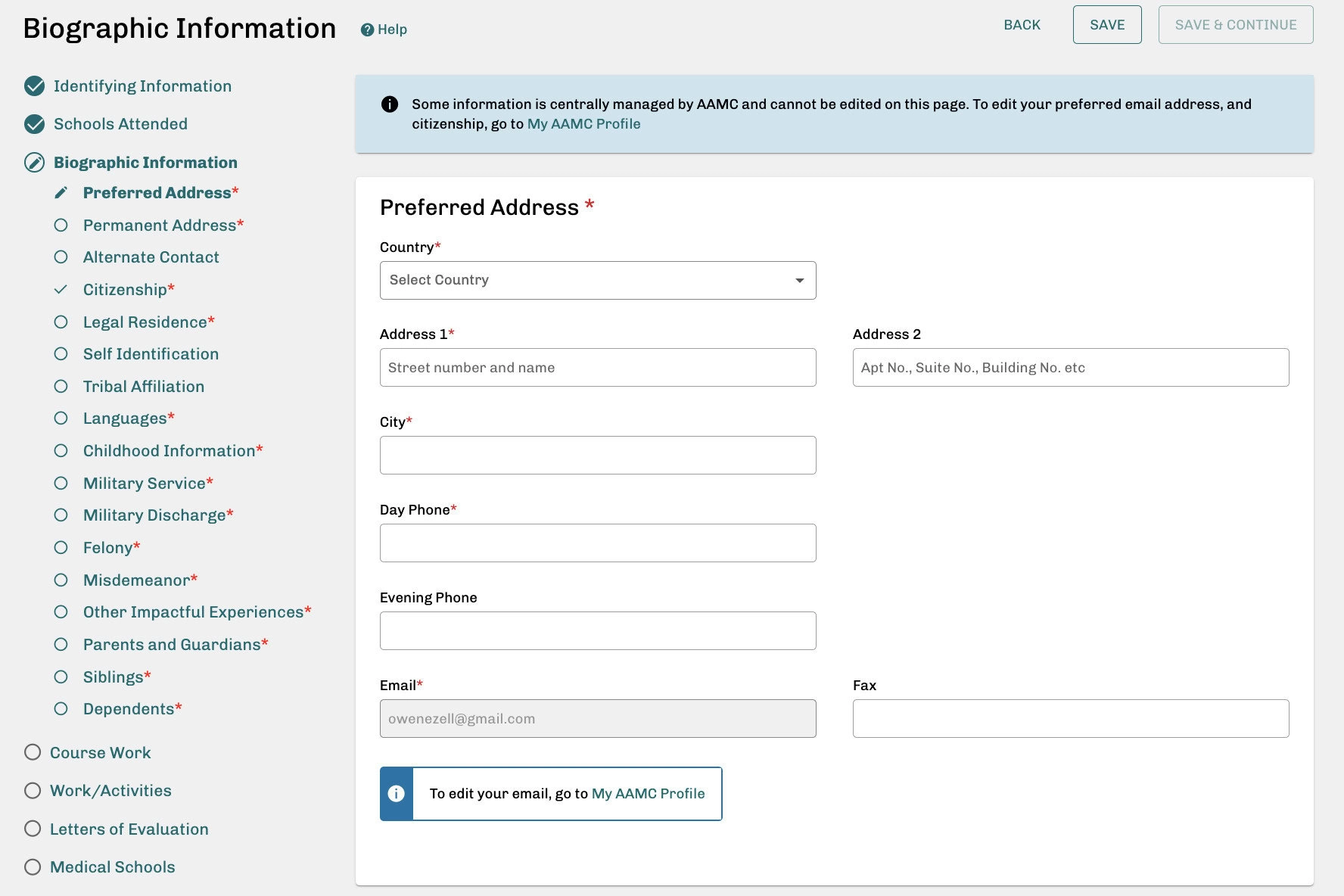
In Section Four, you must enter every course you took at each school — it’s tedious, so have your printed transcripts in hand and settle in for this section.
You will have to complete multiple sections for each course:
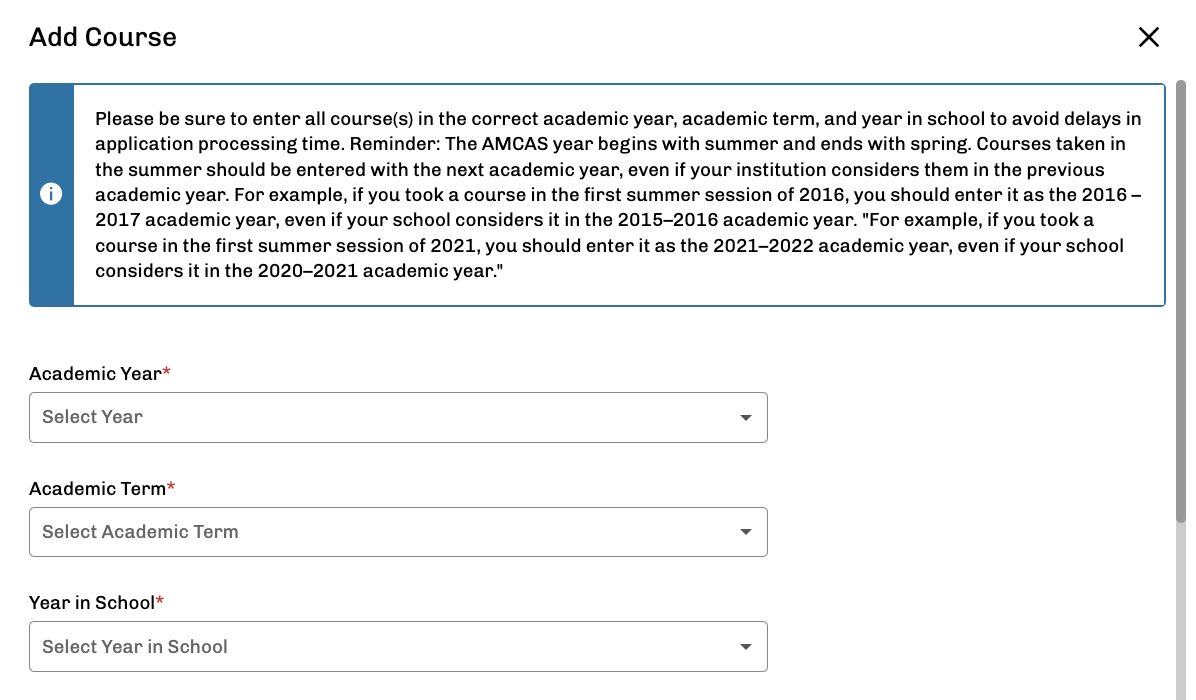
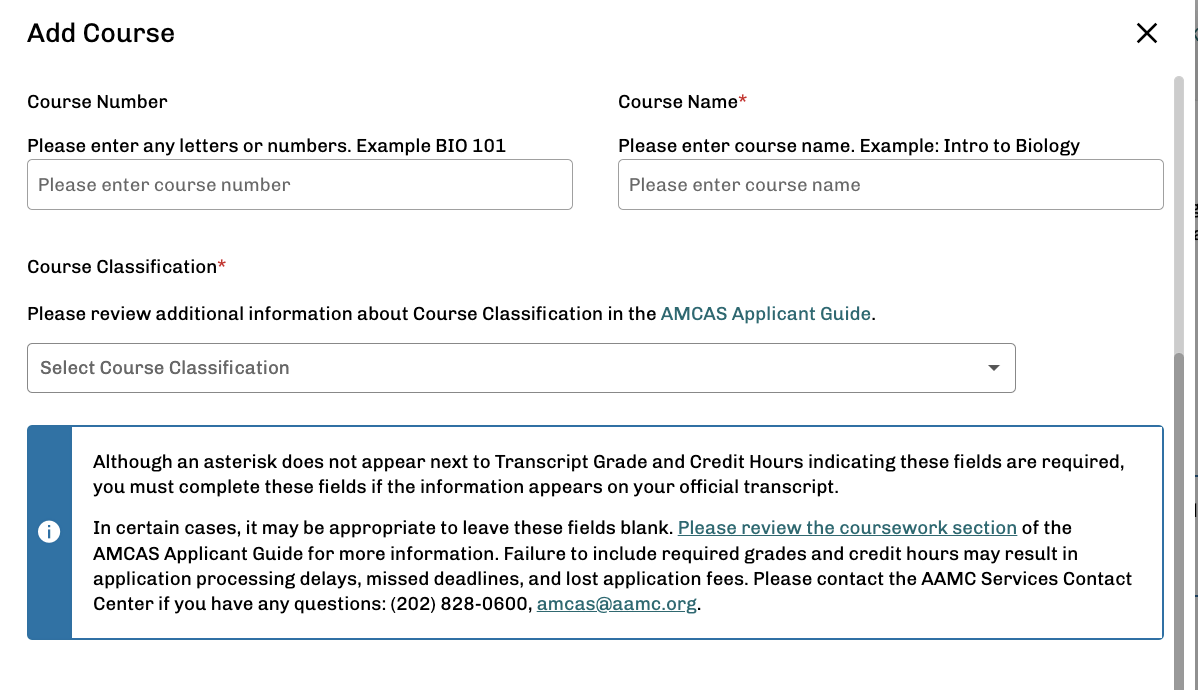
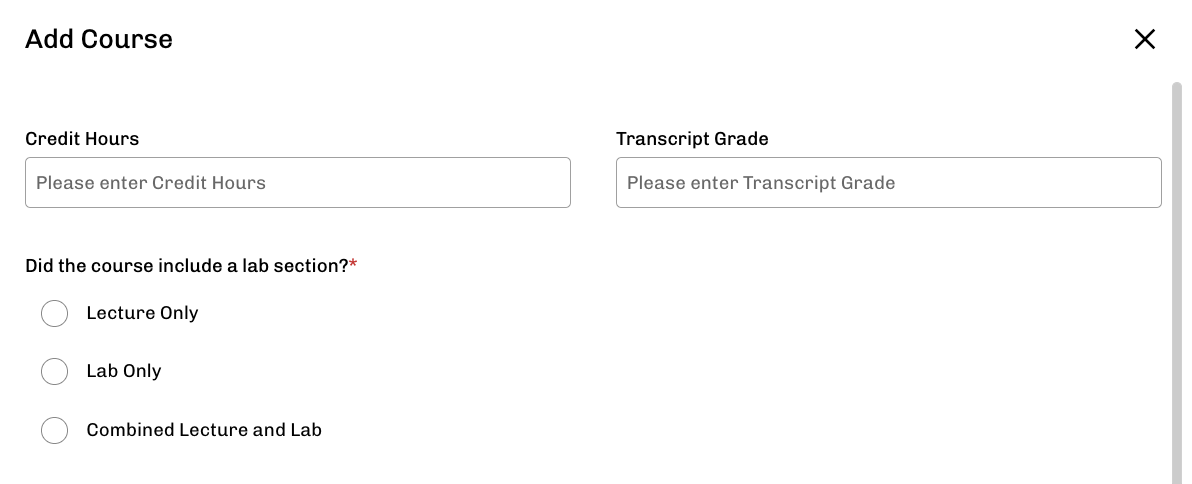
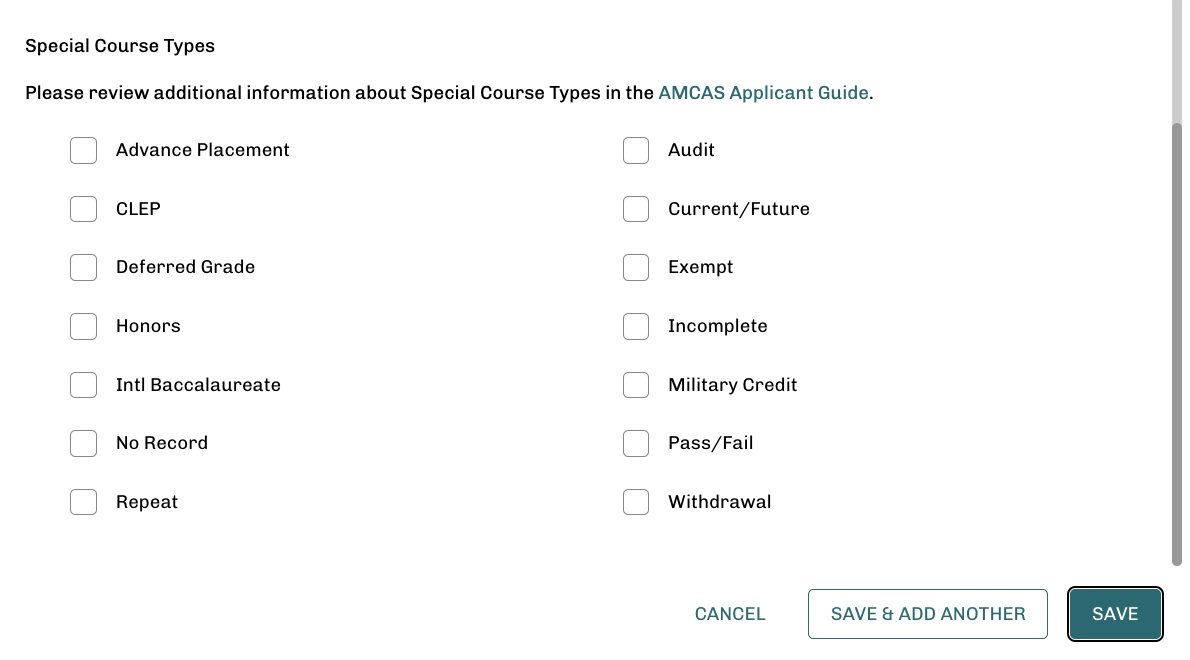
Prior to entering your coursework, the AAMC encourages you to watch some brief tutorials that will guide you through the process:
Pro Tip: Course classification can be tricky. All courses are classified as BCPM science courses (biology, chemistry, physics, math) and AO courses (all others). AMCAS offers a Course Classification Guide that provides examples of how courses are often categorized. Ultimately, you are responsible for selecting the correct course classification, but AMCAS reserves the right to change classifications if the assigned classification clearly does not apply. Misclassified courses may delay the verification of your application. Working with an admissions advisor can ensure you classify courses correctly the first time.
Work and Activities (sometimes shown as Work/Activities) is another hefty section where you get to show what makes you a strong applicant beyond your school work.
There is space for up to 15 work and activity entries (but it’s ok if you don’t have 15). You also have the opportunity to highlight the 3 “most meaningful” experiences to you.
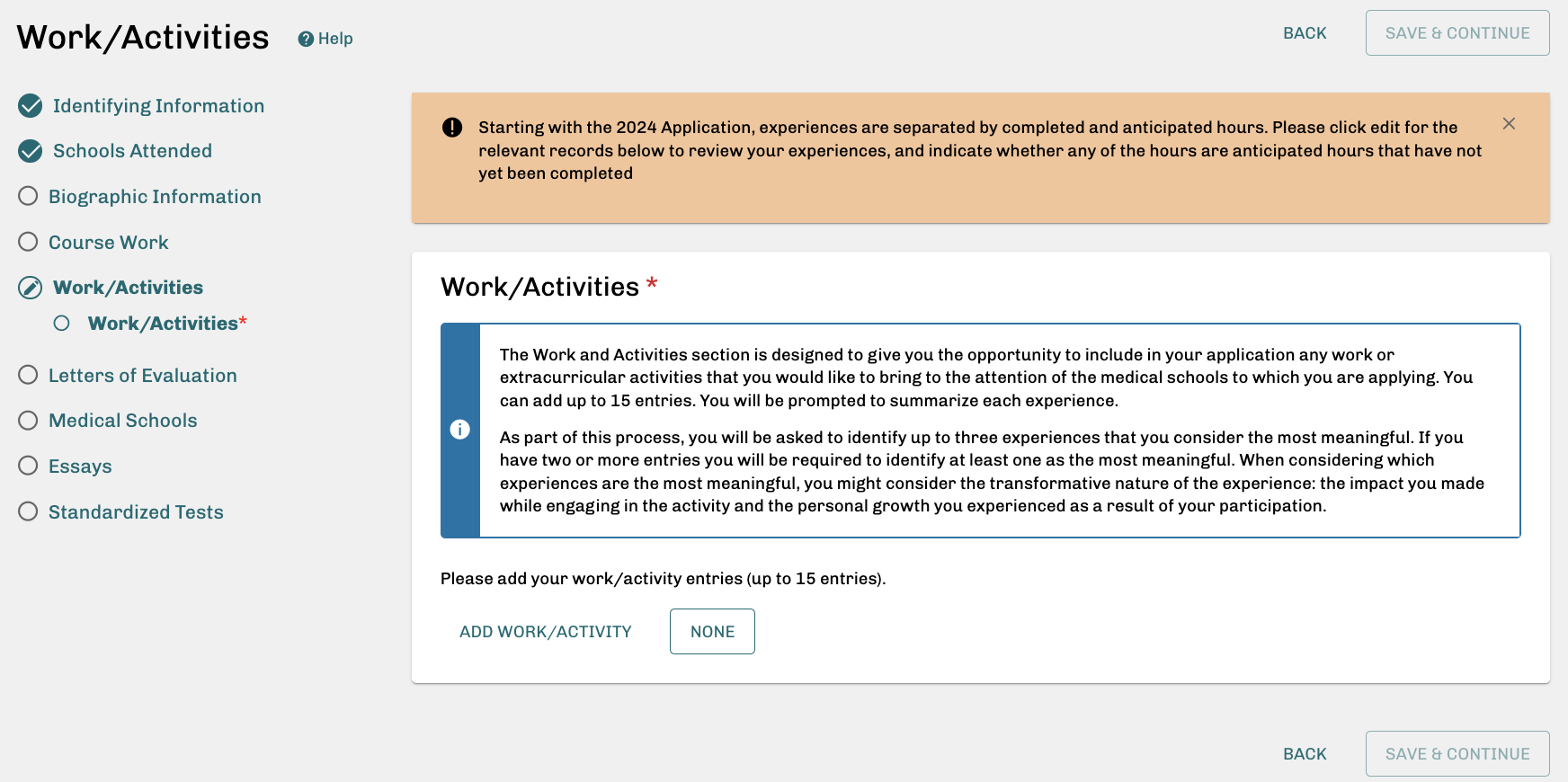
There are 19 Experience Type categories you have to choose for each work/activity entry:
For each activity or work experience, you’ll enter the following information:
The Experience Description box is crucial. Admissions committees are not simply looking for what you did. They want to know the depth of your responsibilities and what you accomplished.
Admissions boards want to hear what qualities you demonstrated, how the experience reflected your values, and how you learned and grew from it — both personally and as it relates to your future career in medicine.
Pro Tip: One of the keys to the Work & Activities section is to show that you’re well-rounded. Admissions committees want to hear about your hobbies and interests outside of your science background, as well.
You have just 700 characters to wrap that up in a nice package.

New for 2024-25, the AAMC AMCAS introduced a new experience type called “Social Justice/Advocacy”. This allows you to let admissions committees know how you’ve worked to improve the rights, privileges, and opportunities of a cause, group, or person.
Dr. Harvey Katzen, Med School Coach Associate Director of Advising“One of the main functions of physicians is to educate. If you can demonstrate you're well-rounded, it shows you’ll be able to find common ground with your patients beyond healthcare, such as sports, literature, or music.”
For schools using the AMCAS Letter Service program, your letters of recommendation (LORs) are another item submitted directly to AMCAS and the medical schools you are applying to.
Since AMCAS doesn’t require a student’s LoRs to verify their application, students may submit their application even if their letters have not yet arrived at AMCAS. The medical schools will receive the application and letters after the application has been fully verified.
Pro Tip: Your letters of evaluation are another way to really set your application apart. Generic LORs will not add value to your application. Get letters from professors, supervisors, and mentors that you had genuine relationships with — people who can speak to your character and accomplishments. Start asking letter writers for LORs 3-4 months beforehand. Check out this article on etiquette for approaching letter writers.
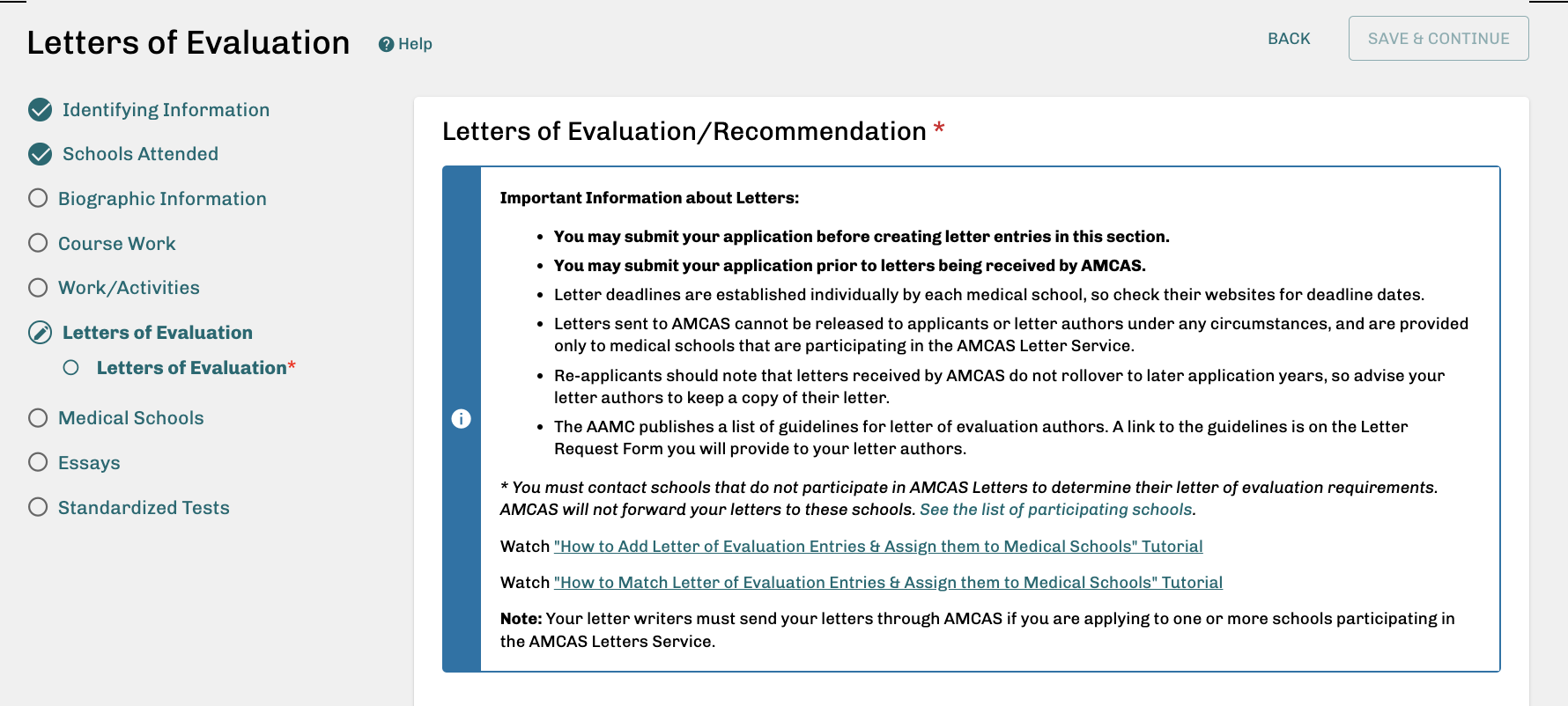
When adding a letter of evaluation or recommendation, you must include a letter title. Make this a meaningful title that you can remember, as you will later need to match letters and assign them to the medical schools you’re applying to.
For each entry, you must choose 1 of 3 types. Each letter type is considered 1 letter entry, regardless of the actual number of letters it contains.
Here are the definitions of the 3 letter types:
Each medical school has a different requirement for letters of recommendation. For example, schools may require a committee letter or letter packet — or 2 letters from science professors plus 1 non-science professor plus 1 to 2 others, including physicians. Check each medical school’s website for their specific requirements.
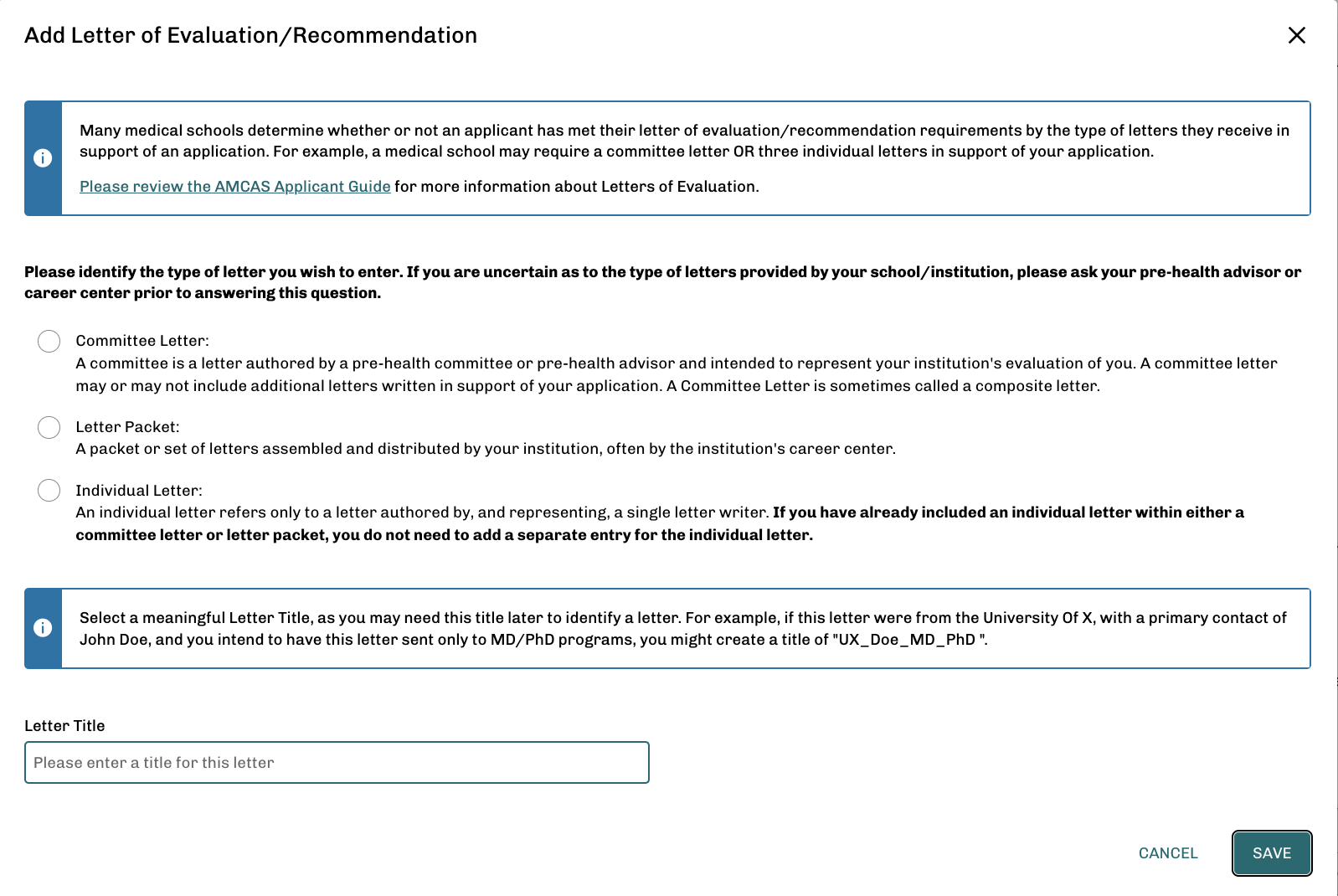
Before completing this section, you will need confirmation from your letter writers. You will add an entry for each letter you’re expecting with the author’s contact information and letter title. AMCAS will then assign an ID number for each letter that the letter writer must include.
After you add each entry, you will be prompted to create a PDF AMCAS Letter Request Form that you will provide to the author.
Dossier services like Interfolio or VirtualEvals can be a great way to store and release confidential letters like these — just be sure to submit only evaluations for the current application cycle.
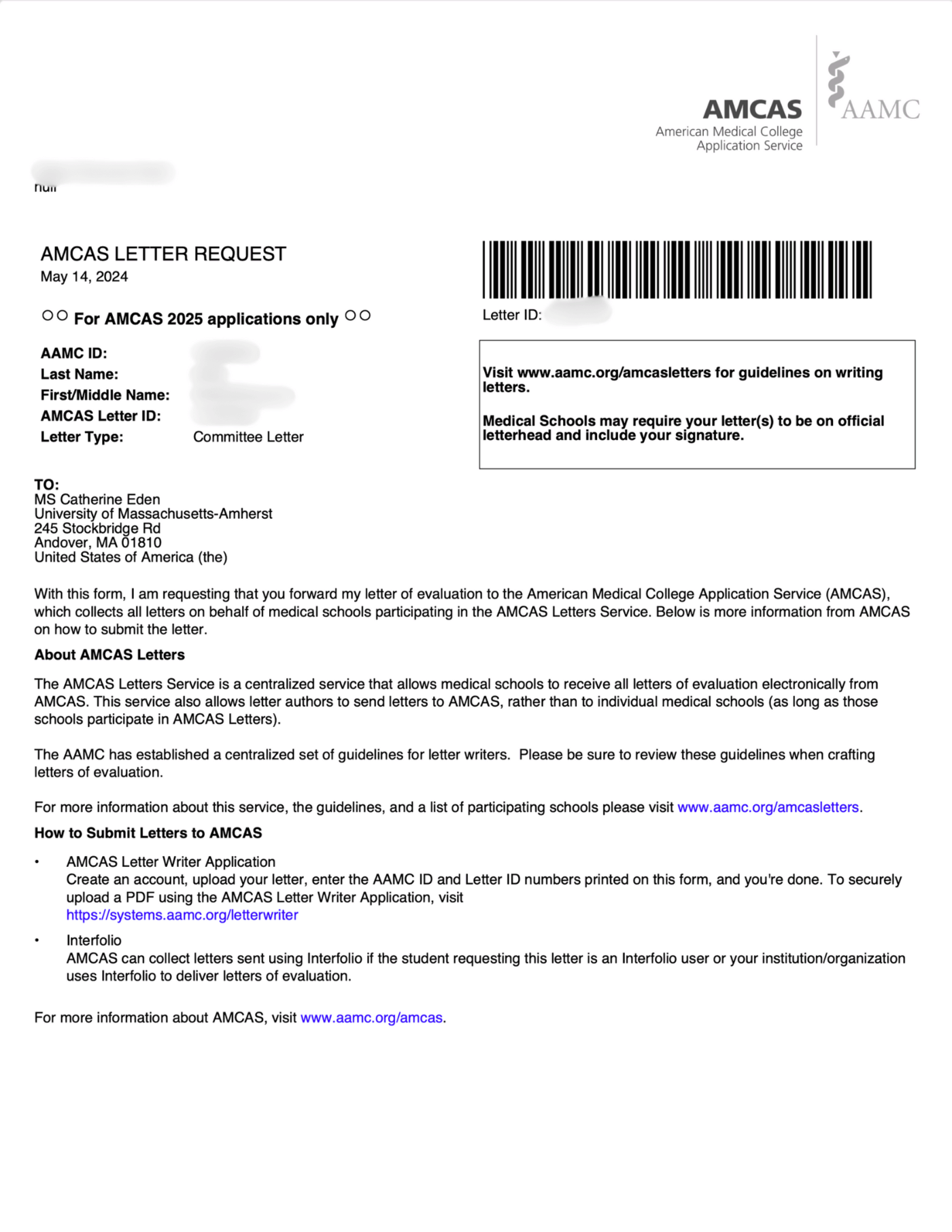
Dr. Ed Lipsit, MedSchoolCoach Associate Director of Advising“Great letters are an absolute must. I was really surprised to find out how seriously committee members take these letters. The fact is, there are so many worthy applicants with great credentials, academics, and activities. They're looking for distinguishing factors, and the quality of your letter is important for a really competitive application.”
In the Medical Schools section, you’ll select all the medical schools you’re applying to.
How many medical schools should you apply to? Admissions advisors from MedSchoolCoach recommend you apply to 25-40 schools, including both in-state and out-of-state schools that you feel are a good match.
You don’t need a full school list at this point; you only need to apply to one school to “submit” your application, which gets most of the heavy lifting out of the way. You can come back and add more schools later, but this first submission of your application is what gets the verification process started.
For each school you add, select a program and declare whether you’ve previously applied to that school. You will be able to see whether or not the school participates in the AMCAS Letter Service and the AMCAS-facilitated Criminal Background Check.
If you have entered letters of recommendation, you will also have the opportunity to assign a letter to each school at this point.
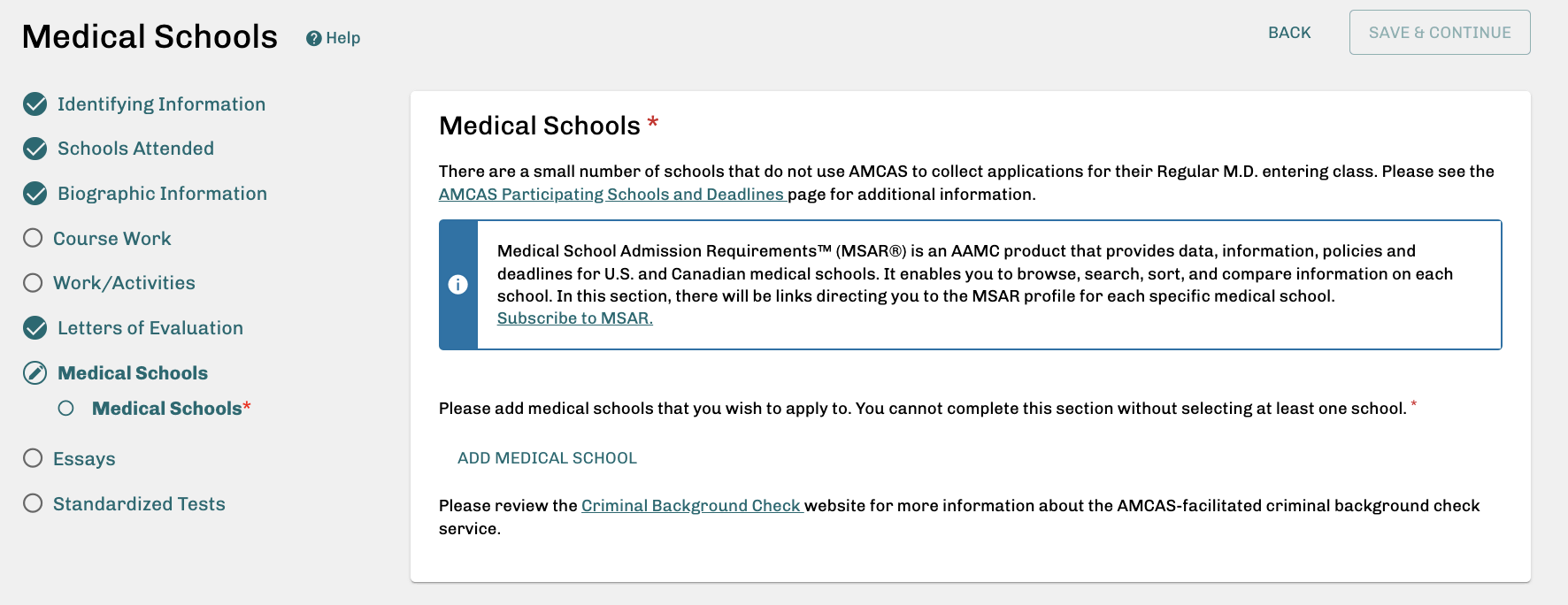
As you add schools, you will have a helpful dashboard where you can see each med school, the program you’re applying to, and the transcript and application deadlines. Here, you’ll also see your application fees start to add up.
How many schools can I apply to with AMCAS? You can apply to as many schools as you want with the AMCAS, as long as they accept the application service.
The fee is $175 to send your application to the first school and $46 for each additional school.
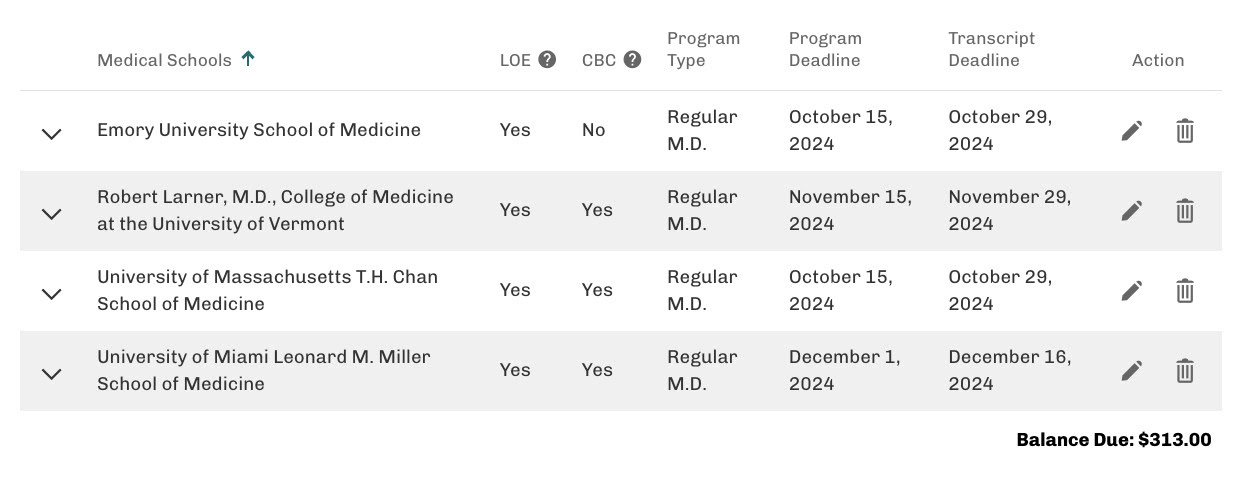
While it’s wise to apply to multiple schools, a lot of thought should go into cultivating your school list. In-state tuition is almost always going to be cheaper than out-of-state, but you also need to consider factors like the mission of the school (is it focused on primary care or research?), proximity to family, and preference for culture and climate.
Schools should also be an academic match and best suited to your professional experience.
Dr. Ed Lipsit, MedSchoolCoach Associate Director of Advising"Definitely cast a wide net. However, also try to be smart about the list you create. There are a lot of factors that go into creating a solid school list – how competitive an applicant you are, what aspects of medicine you’re interested in, the financial impact of applying to many schools. I would encourage you to work one-on-one with an advisor to create a smart, practical school list that maximizes you chance of success.”
Your personal statement, which is within the Essays section, is arguably the most important part of the application.
A strong medical school personal statement speaks volumes about your potential to succeed in medical school. It can demonstrate to admissions committees your potential as a future physician and how you’ll contribute to their school. Additionally, it helps to distinguish you from other applicants with similar GPAs and MCAT scores.
Likewise, an unimpressive personal statement can ruin your chance of getting an interview. A poorly-written personal statement with typos that lacks content is pretty much a deal breaker when admissions committees have hundreds of applications to review.
The challenge with this section is how deceptively simple it looks on the AMCAS application: “Use the space provided to explain why you want to go to medical school.” And you have 5,300 characters — or around 500 words to do it. No pressure!
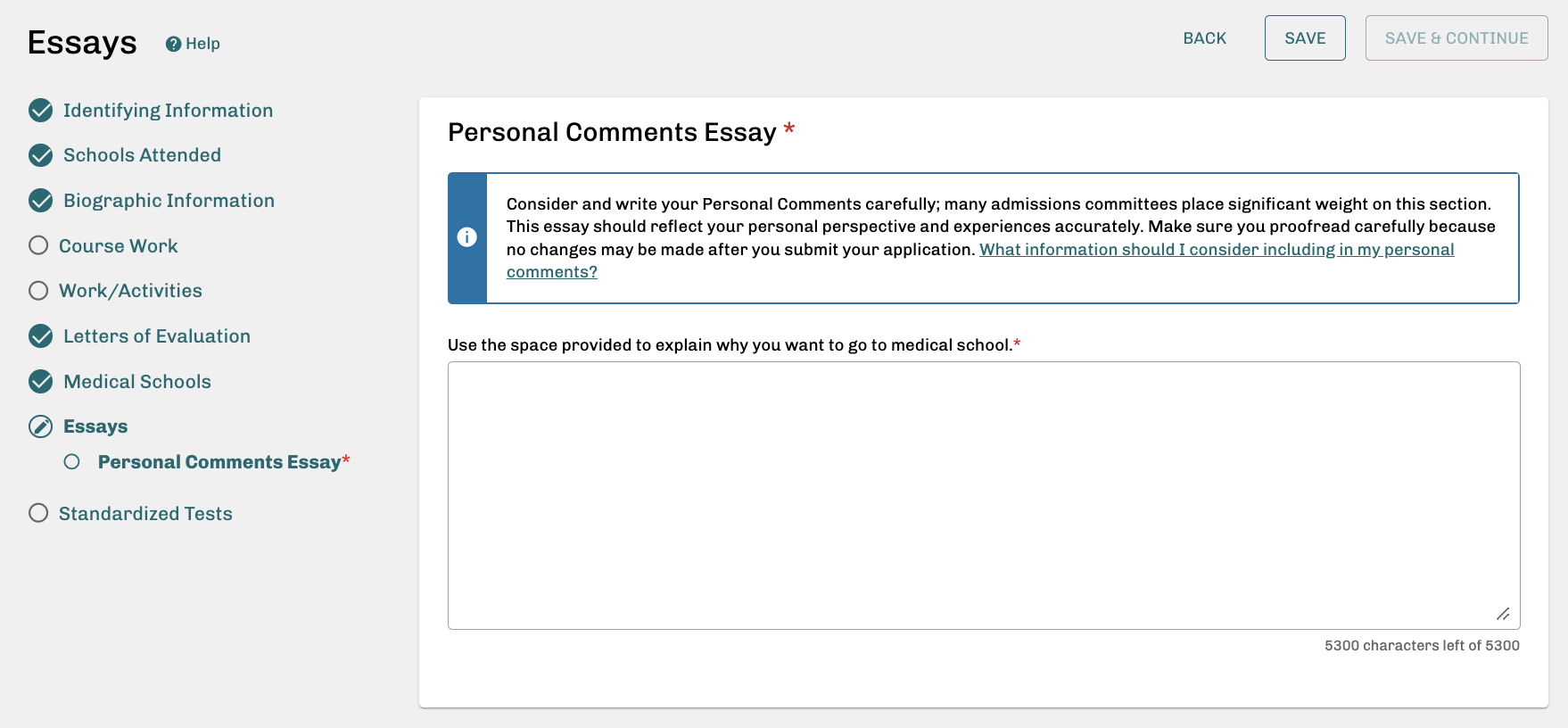
If you click the link provided in this section, AMCAS does give you a bit more guidance for what to write about.
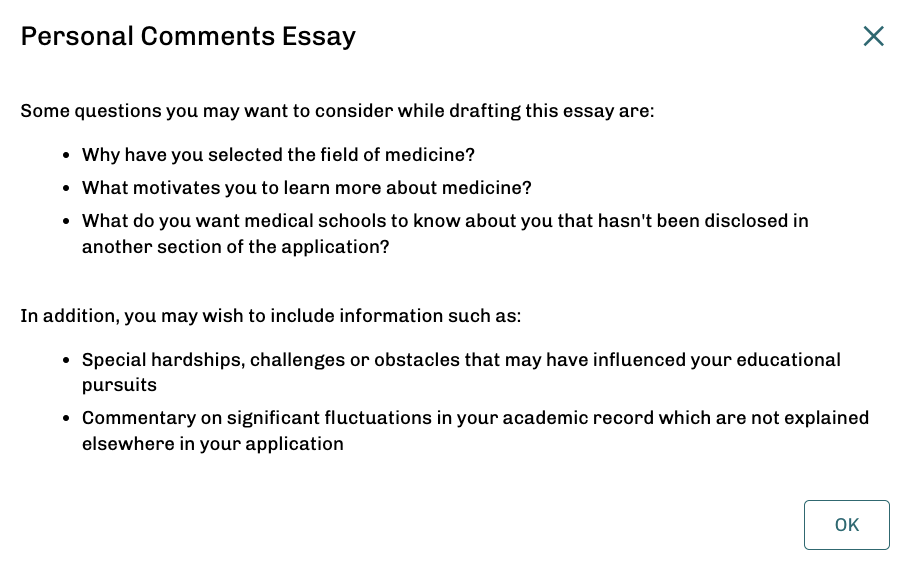
Advice for writing a standout personal statement:
That last point about using AI to write is really important. One of the few changes between the 2023/24 and 2024/25 AMCAS applications is the addition of the instruction here: “This essay should reflect your personal perspectives and experiences accurately and must be your own work and not the work of another author or the product of artificial intelligence.”
Seriously, just don’t do it.
Things NOT to include in your personal statement:
It may help you write your personal statement if you break it into smaller, manageable chunks. In general, think about your essay containing 4-5 components:
Begin as early as December/January if you plan to apply in May/June.
Get opinions from others. Have others read your essay, but be selective about who you ask. A professor, work colleague, or a medical student are likely better options than a family member.
Some personal essay ideas to think about:
Check out outstanding personal statement examples here.
Standardized Tests is the final section. Congratulations on making it this far!
If you have already taken the MCAT, your scores are automatically released to AMCAS and will be visible here. If you haven’t taken the MCAT yet, or if you plan to retake it and have a test date scheduled, you can indicate that here and your latest test score will be updated when released.
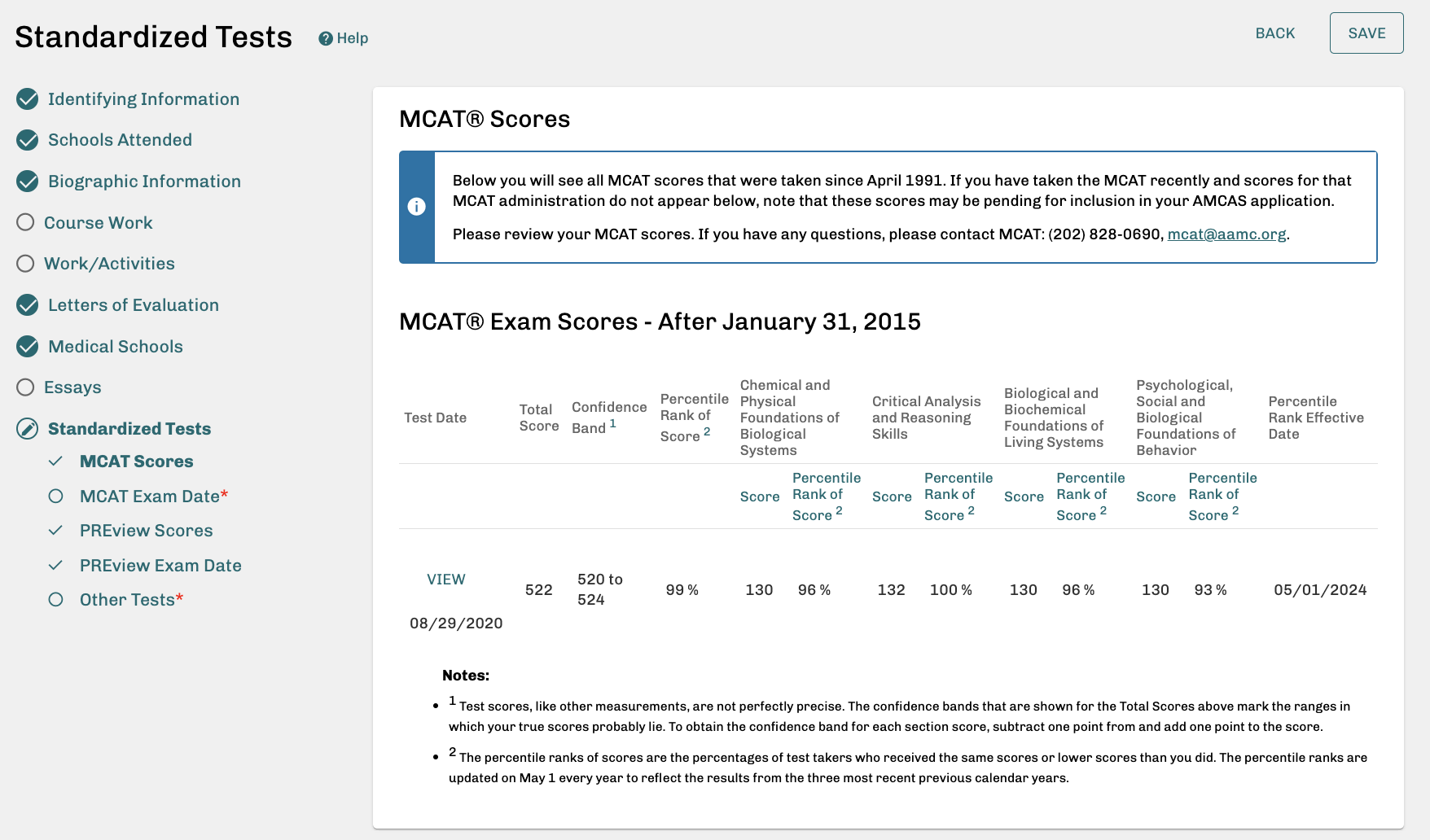
After the MCAT details, you’ll be able to see previous or upcoming AAMC PREview exam dates and your scores, if you’ve already sat for this situational judgment test.
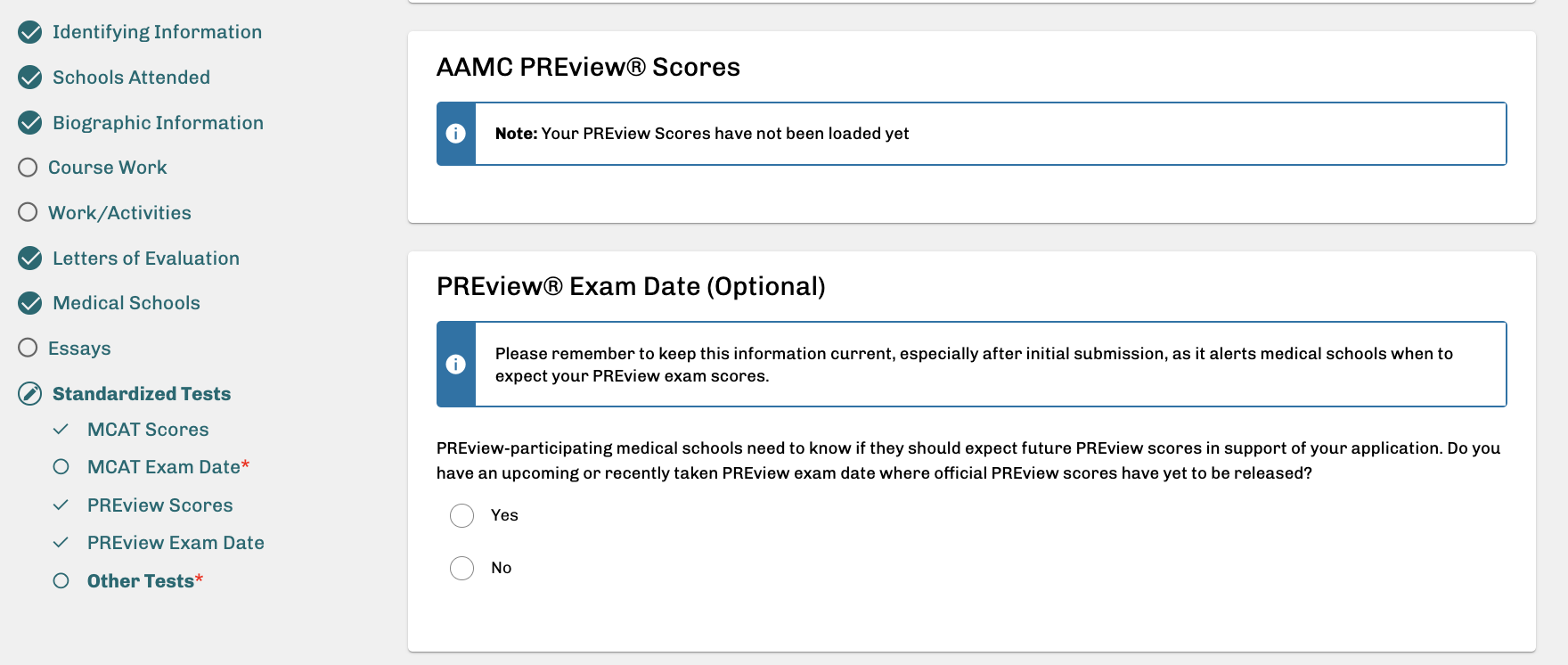
Below the AAMC PREview details, you can add details from other situational judgment tests (like Casper). This is also where you have the opportunity to enter any additional standardized test scores, such as GRE, LSAT, or GMAT.
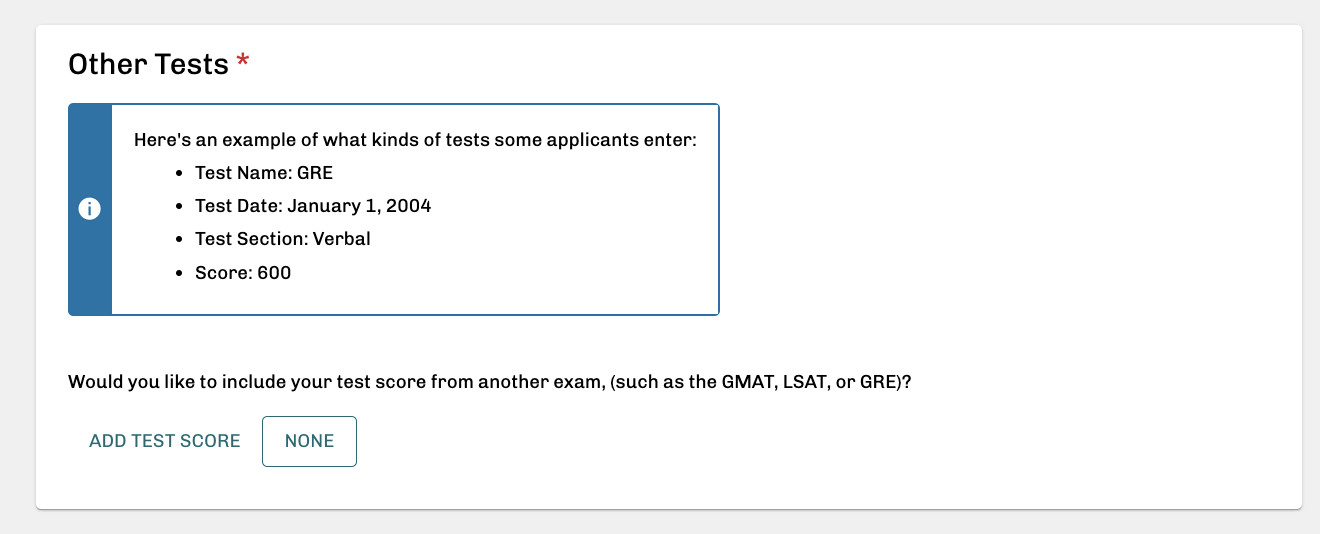
From your main application menu, you have the opportunity to go back into every section and make changes. Check and double-check everything.
CAUTION: If you have completed the AMCAS sections in order, and each section on the left has a check mark circle next to it, then as soon as you save your standardized tests sections — you will be asked if you want to submit your application.
WE HIGHLY RECOMMEND YOU SAY NO. It’s always a good idea to go back and carefully review each section to check for errors, accuracy, and completion.
When you’re ready, click “Submit Application.”
Once your review is complete and you’re ready to submit, the application will walk you through a few final steps, beginning with pre-submission checks and certification. AMCAS does a great job of telling you what you still need to do in the Pre-Submission Checks, such as assigning letters of recommendation to medical schools. Remember, letters can be added and assigned at a later date as you get confirmations from letter writers.
From here, you will complete the following to officially submit your application:
Certification: This acts as your legal signature to certify everything on your application is accurate. There are 13 statements to read, check, and agree to on this page.
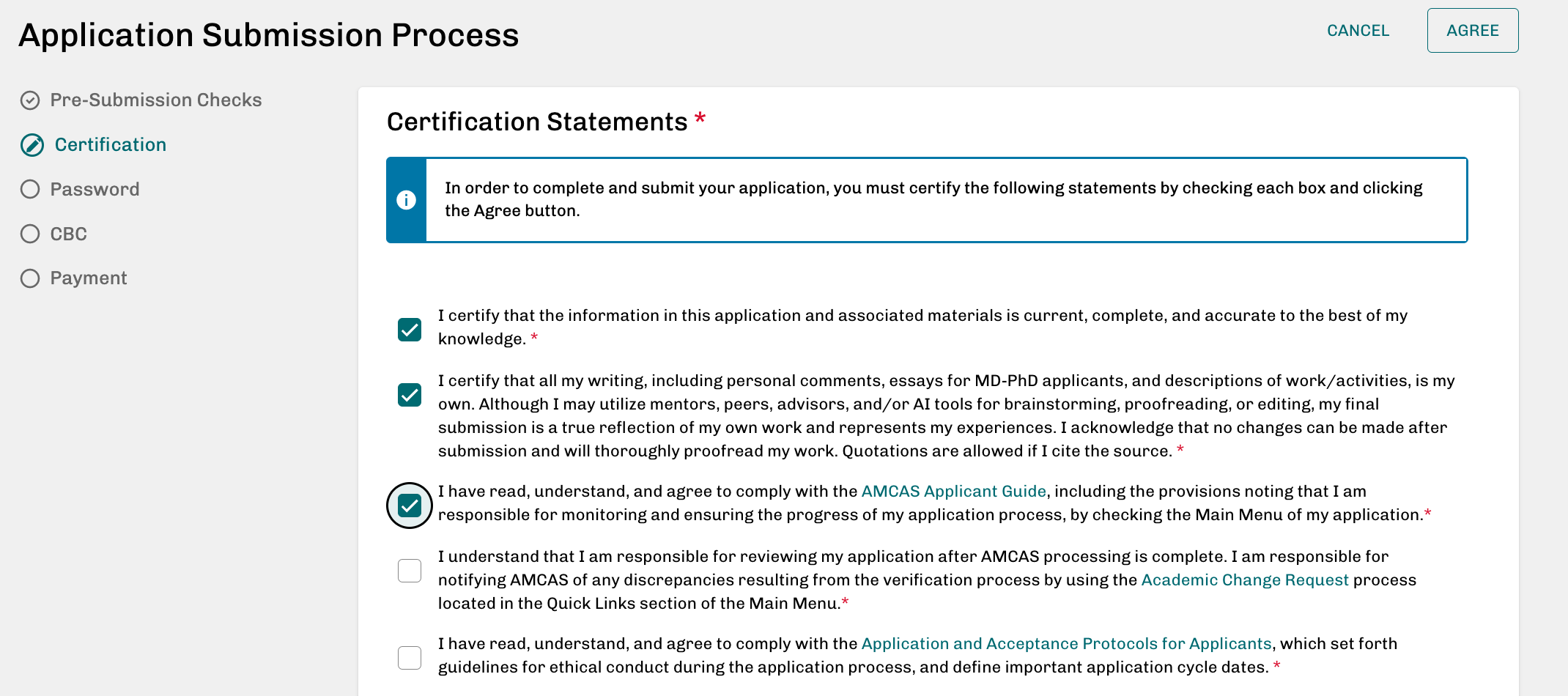
Password: Under this section, you’ll have the opportunity to print your application. Even if you don’t physically print it, the file will open as a PDF and you can read through it.
The PDF form is exactly what medical school admissions committees will receive. We highly recommend you save or print this PDF form. If you find any errors, you can still go back and edit your application before continuing the submission process.
When you’re satisfied with your application, you will enter your AMCAS password to certify that you understand that you may not change, correct, or update selected parts of the application as outlined in the AMCAS Applicant Guide once it has been submitted to AMCAS.
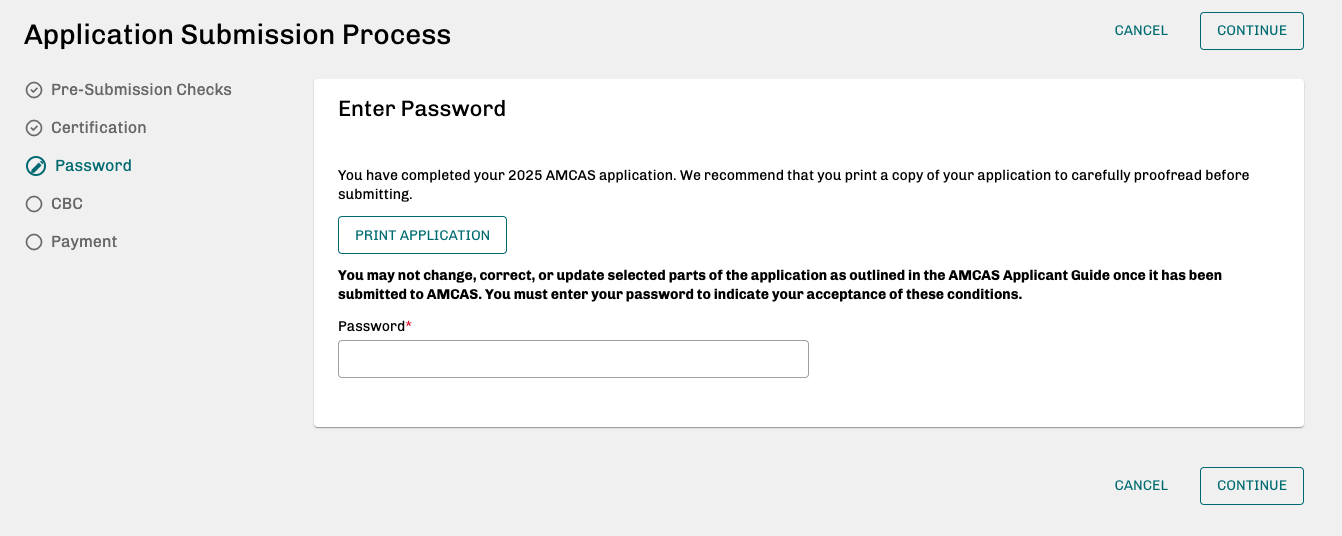
CBC (Criminal Background Check): This page informs you that AMCAS partners with Certiphi Screening, Inc. to perform criminal background checks. Upon your initial, conditional acceptance by a participating medical school, Certiphi Screening, Inc. will send an email with additional information to your preferred email address to start your background check.
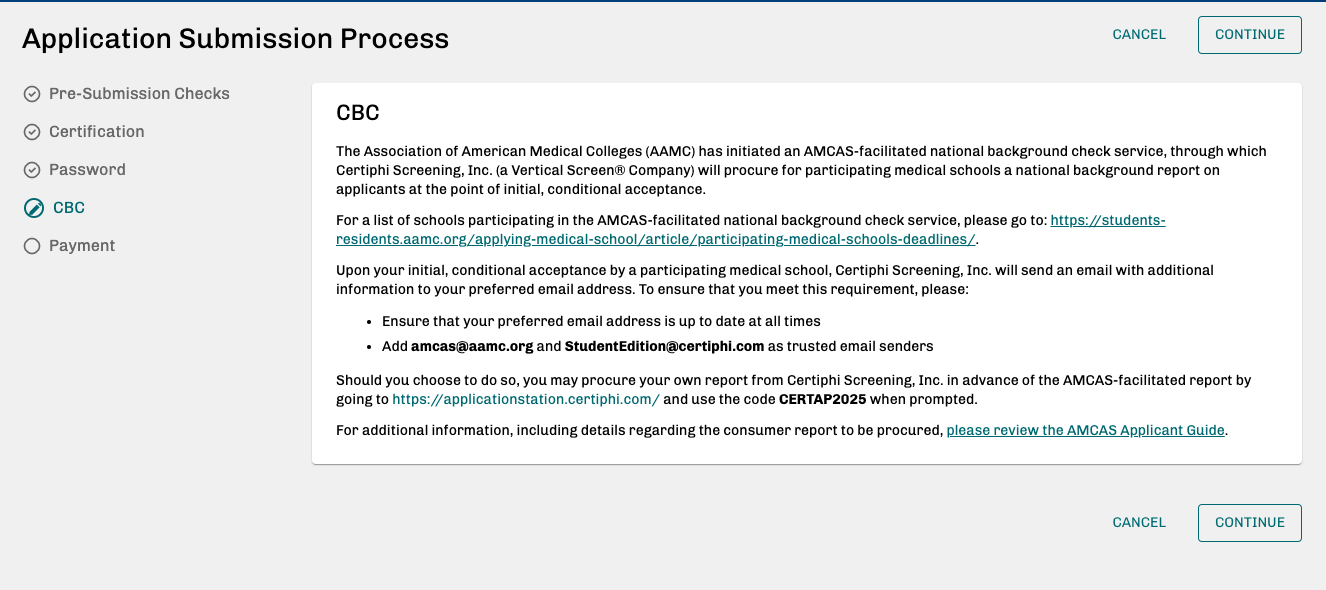
Payment: The final section is where you’ll pay your application fees.
For students who need financial aid for fees, AAMC offers a fee assistance program.
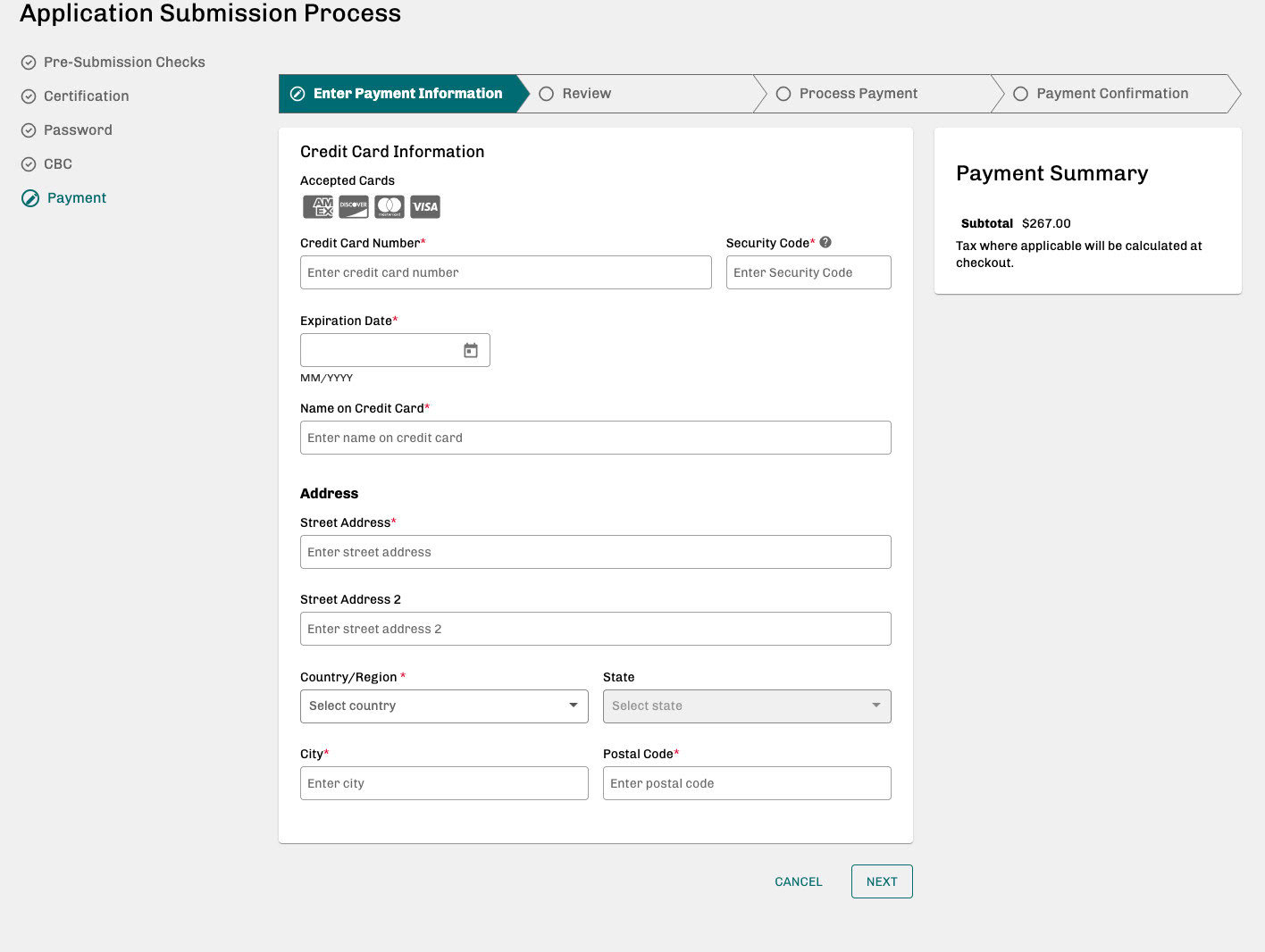
Once your payment is confirmed, your application is officially submitted.
To submit an Academic Change Request, select one of the following reasons and include an explanation:
The verification process can range from a few days to a few weeks. This process can be delayed if there are errors on your application, such as misclassified coursework.
In order for your application to be placed in the queue for verification, the following are required:
These items are not required for verification and they will not delay the verification of your application:
Once you submit your application, you’ll want to closely monitor its verification status. On the top right corner of your main menu, you will see a blue status. You can also click “View Application Status History” at any time to see a record of updates.
It’s important to understand the meaning of each status so that you can track your application and know if you need to take some action:
You can edit the following types of information after submitting your AMCAS:
The AMCAS application costs $175 to send your application to the first school and $46 for each additional school.
To be eligible for AAMC’s financial assistance, you must have a US-based address, and your total family income for 2023 must be under 400% of the national poverty line for your family size.
Below are the benefits of AAMC’s 2024 fee assistance program:
The AACOMAS (American Association of Colleges of Osteopathic Medicine Application Service) is the application for osteopathic medical schools outside of Texas. You’ll fill this out if you’re pursuing DO schools as part of your medical school application process.
The AMCAS (American Medical College Application Service) is the application for allopathic medical schools outside of Texas. All prospective students interested in MD schools will use this application.
The TMDSAS (Texas Medical and Dental Schools Application Service) is used for all medical programs in Texas. The Texas legislature has a strict 10% cap on non-resident medical students, which means 90% or more of the matriculants to Texas medical programs are in-state residents.
The good news is that most of the information on your AMCAS application will remain the same when you reapply. Here are the sections reapplicants should consider updating:
If you struggled with your AMCAS application the first time, expert admissions advisors can help you prepare for your reapplication, increasing your chances of acceptance.
Advisors with prior admissions committee experience can provide honest feedback on your qualifications and help you update your application to improve your chances of getting into the medical school of your choice.
Eligibility and financial aid differ for international students, and English language proficiency is required at almost all US medical schools. International students cannot submit international transcripts that are not accredited by an American, US territorial, or Canadian post-secondary institution.
Applicants who matriculate to allopathic medical school via AMCAS have an average GPA of 3.77 and an average MCAT score of 512. If your metrics are lower than these, don’t worry — there’s definitely still hope. A high GPA can offset a low MCAT score, and vice-versa.
According to AAMC data, those who score a mere 506 on their MCAT can still achieve more than a 50% chance of acceptance, provided their GPA is high enough. Likewise, those with a 3.20 GPA can raise their odds above 50% by scoring well on the MCAT.
Check out the AAMC’s acceptance rate table to find your odds of admission at your current GPA and MCAT score.
Avoid these common mistakes on the AMCAS application:
Yes, you can add new medical school choices and designations even after you’ve submitted your application, as long as the deadline for that program’s application has not passed. You will need to pay an additional fee for each added school.
You must access your online AMCAS application to check for status updates.
If you are considering early decision, talk to an advisor or someone with great familiarity with the admissions process. Early decision programs are usually only recommended for a select group of students with specific credentials.
Also, applying early decision means you can’t apply to more than a single program. If you are denied, you may not be able to apply elsewhere in time to get accepted during this application cycle.
The 2024-2025 AMCAS deadline for submitting is 11:59 p.m. EST on the deadline date. The deadline date for each medical school is different. Some schools require submissions as early as September, but others allow submissions as late as January.
The early decision deadline is August 1, 2024.
Note: Don’t wait until near the deadline to submit your application! The overwhelming majority of students accepted to medical schools apply earlier in the cycle. That’s why we recommend submitting your primary application no later than the first week of June, if at all possible.
Secondary applications (supplemental applications) are school-specific forms sent to applicants after the primary application is submitted.
Med schools’ secondary applications gather additional information about students to evaluate whether they’re a good fit for that institution.
Looking to craft a stand-out application and ultimately achieve your dream of becoming a physician? MedSchoolCoach can help. Our admissions experts work with hundreds of students each year, providing step-by-step guidance throughout the admissions process.
This 1-on-1 mentorship is why 92% of MedSchoolCoach clients get accepted into medical school – double the acceptance rate for the average applicant.
Ready to 2x your odds of med school acceptance?

Dr. Marinelli has practiced family medicine, served on the University of California Admissions Committee, and has helped hundreds of students get into medical school. She spearheads a team of physician advisors who guide MedSchoolCoach students.